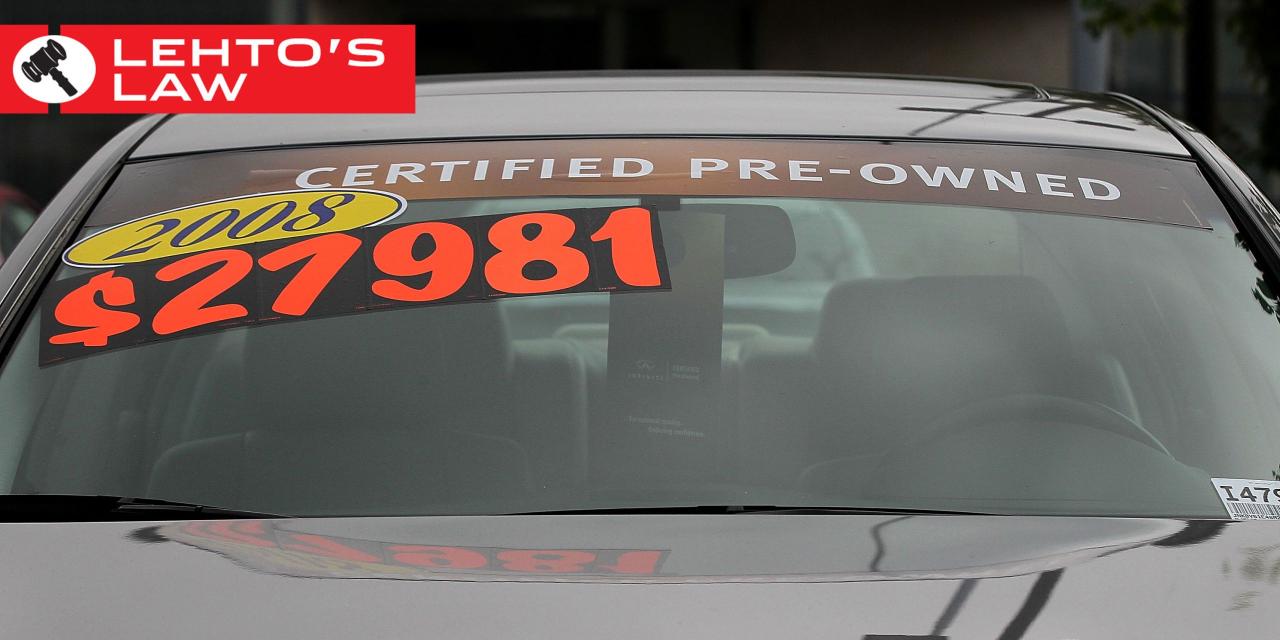What is a certified pre-owned car warranty? It’s basically insurance for your slightly-used ride! Buying a used car can be a gamble, but a CPO warranty adds a layer of protection, saving you from potentially huge repair bills. Think of it as a safety net—a promise from the manufacturer or dealership that they’ll cover certain repairs for a set period.
This isn’t just any used car warranty; CPO warranties usually offer more comprehensive coverage and peace of mind. Let’s dive into the details and see if it’s the right choice for your next car.
Certified pre-owned (CPO) car warranties are offered by manufacturers on used vehicles that have passed a rigorous inspection process. This inspection typically covers everything from the engine and transmission to the electrical system and bodywork. If the car meets the manufacturer’s standards, it receives CPO certification and comes with an extended warranty. This warranty usually covers repairs for a specific time period or mileage, providing buyers with protection against unexpected mechanical problems.
The specifics of the coverage vary between manufacturers and models, so it’s important to read the fine print before purchasing a CPO vehicle.
Definition of a Certified Pre-Owned (CPO) Car Warranty
Buying a used car can be a bit of a gamble, but certified pre-owned (CPO) vehicles offer a level of reassurance you won’t find with just any used car. A CPO car is essentially a used vehicle that’s been inspected and reconditioned to meet certain standards set by the manufacturer. The big draw? The CPO warranty. This warranty provides extra peace of mind beyond what a typical used car sale might offer.A CPO warranty is a manufacturer-backed warranty offered on used vehicles that have passed a rigorous inspection process.
Unlike a standard used car warranty, which is often offered by the dealership and may vary wildly in coverage, a CPO warranty comes directly from the manufacturer and typically offers more comprehensive protection. Think of it as a mini-new-car warranty for your pre-owned ride. This often includes coverage for major components that could lead to expensive repairs down the road.
Coverage Provided by CPO Warranties
CPO warranties generally cover a broader range of components and offer a longer duration of coverage compared to standard used car warranties. The specifics will vary between manufacturers, but common inclusions might involve powertrain components (engine, transmission, and drive axles), electrical systems, and other key parts. For example, many CPO programs cover repairs to the air conditioning system, the braking system, and even certain aspects of the vehicle’s electrical system.
So, you’re looking at a certified pre-owned (CPO) car – awesome! A CPO warranty usually covers repairs for a set period after purchase, offering peace of mind. But before you commit, make sure to thoroughly inspect the vehicle; check out this guide on How to test drive a car like a pro to really know what you’re getting.
Understanding the warranty’s specifics and performing a solid test drive are key to making a smart CPO car purchase.
Some programs even extend to things like the infotainment system, offering protection against malfunctions beyond just the core mechanical aspects of the car.
Variations in Manufacturer CPO Programs
Different manufacturers have different CPO programs, resulting in variations in coverage levels and durations. For instance, some manufacturers might offer a longer warranty period than others, perhaps covering up to 7 years or a certain mileage limit. Others may offer more extensive coverage, including roadside assistance, rental car reimbursement in the event of a covered repair, or even additional benefits like extended warranties on specific components.
A BMW CPO program might differ significantly from a Honda CPO program, so researching the specifics of each manufacturer’s program before purchasing is crucial. Comparing the details, such as the length of the warranty, the mileage limits, and the specific components covered, is essential for making an informed decision. Reading the fine print of each program’s terms and conditions is also highly recommended.
Coverage Details of a CPO Warranty: What Is A Certified Pre-owned Car Warranty?
Certified Pre-Owned (CPO) warranties offer peace of mind, but understanding their specifics is key. These warranties aren’t identical across brands; coverage varies significantly, impacting the value proposition. This section details what’s typically included, excluded, and the timeframe you can expect protection.
So, you’re wondering about a certified pre-owned car warranty? Basically, it’s an extended warranty offered by dealerships, giving you some peace of mind. But if you’re buying privately, you’re on your own, so checking everything thoroughly is key. Before you sign anything, make sure you carefully review everything, as outlined in this super helpful guide: What to check when buying a used car privately.
Understanding what’s covered (or not) in a CPO warranty is super important, especially when comparing it to the risks of a private sale.
Covered Repairs Under a Typical CPO Warranty
A typical CPO warranty covers repairs related to mechanical and electrical components. For instance, if your engine throws a rod (a catastrophic engine failure), or your transmission starts slipping, the warranty likely covers these significant repairs. Smaller issues, such as a failing power window motor or a malfunctioning air conditioning compressor, are also often included. Think of it as a safety net against unexpected and costly mechanical breakdowns.
The specific components covered vary by manufacturer and the specific CPO program details.
Common Exclusions and Limitations
While CPO warranties provide substantial coverage, they usually exclude certain items. Wear-and-tear items like tires, brake pads, and wiper blades are generally not covered. Damage resulting from accidents, neglect, or modifications is also typically excluded. Furthermore, some CPO warranties might have mileage limitations, meaning coverage ceases once a certain mileage threshold is reached, regardless of the warranty’s time limit.
It’s crucial to carefully read the fine print of the specific warranty you’re considering.
Duration and Mileage Limits of a Typical CPO Warranty
The length and mileage limits of a CPO warranty vary by manufacturer and the specific vehicle. However, a common range is between 12 and 36 months, with mileage limits ranging from 12,000 to 100,000 miles. Some manufacturers offer extended coverage for an additional fee. For example, Manufacturer A might offer a 12-month/12,000-mile CPO warranty, while Manufacturer B provides 24 months/50,000 miles.
Always confirm the exact terms with the dealership or manufacturer before purchasing a CPO vehicle.
Comparison of Three CPO Warranty Programs, What is a certified pre-owned car warranty?
| Manufacturer | Duration | Mileage Limit | Additional Benefits |
|---|---|---|---|
| Manufacturer A | 12 Months | 12,000 Miles | 24/7 roadside assistance |
| Manufacturer B | 24 Months | 50,000 Miles | Powertrain coverage only |
| Manufacturer C | 36 Months | 100,000 Miles | Comprehensive coverage, including wear and tear items (with deductible) |
Benefits of Purchasing a CPO Car with a Warranty
Buying a certified pre-owned (CPO) car offers a compelling alternative to purchasing a brand-new vehicle, especially when coupled with a warranty. The peace of mind and potential cost savings make it a smart financial decision for many car buyers. Let’s explore the advantages in detail.Choosing a CPO vehicle with a warranty significantly reduces the risk associated with used car purchases.
Unlike buying a used car from a private seller, where you’re largely on your own should something go wrong, a CPO warranty provides a safety net against unexpected and potentially costly repairs. This translates to significant financial peace of mind. The lower purchase price compared to a new car, combined with the warranty protection, makes CPO vehicles an attractive option for budget-conscious consumers.
Reduced Financial Risk and Peace of Mind
The biggest benefit of a CPO warranty is the substantial reduction in financial risk. Imagine the scenario: you buy a used car, and a major component like the transmission fails just a few months later. Without a warranty, you’re facing a potentially crippling repair bill. A CPO warranty, however, typically covers major components for a specified period, shielding you from such unexpected expenses.
This peace of mind allows you to enjoy your vehicle without the constant worry of looming repair costs. For example, a warranty might cover the engine, transmission, and other major systems for up to a year or a specific mileage limit. This provides significant protection against costly repairs.
Cost Savings Compared to New Cars
CPO vehicles offer significant cost savings compared to buying new. The depreciation hit a new car takes the moment it leaves the dealership is substantial. By opting for a CPO car, you avoid that immediate depreciation and save a considerable amount of money upfront. Furthermore, the lower purchase price combined with the protection of a warranty means your overall ownership costs could be significantly lower than with a new car, especially over the warranty period.
For instance, a three-year-old CPO vehicle might cost thousands less than a brand-new model of the same make and model, and the warranty could save you thousands more on potential repairs during that same three-year period.
Protection Against Unexpected Repair Costs
A CPO warranty acts as a crucial buffer against unexpected repair bills. While regular maintenance is important for any vehicle, unforeseen mechanical issues can arise at any time. These issues can range from minor inconveniences to major repairs costing thousands of dollars. The CPO warranty covers many of these potential problems, significantly reducing your out-of-pocket expenses. For example, if your car’s electrical system malfunctions, or a critical sensor fails, the warranty would typically cover the cost of diagnosis and repair, providing significant financial relief.
Advantages of a CPO Warranty: A Summary
The advantages of purchasing a CPO car with a warranty are numerous. To summarize:
- Significant cost savings compared to buying a new car.
- Reduced financial risk due to coverage of major repairs.
- Peace of mind knowing you are protected against unexpected repair bills.
- Access to a vehicle that has undergone a rigorous inspection and reconditioning process.
- Extended warranty coverage beyond the manufacturer’s original warranty.
Process of Obtaining a CPO Warranty
Getting a certified pre-owned (CPO) car with a warranty involves several steps, from finding the right vehicle to understanding the paperwork. The process is generally straightforward, but understanding each stage can help ensure a smooth transaction and give you confidence in your purchase.The process begins with locating a CPO vehicle from a dealership or authorized seller. Dealerships often have a dedicated section for their CPO inventory, making it easy to browse options.
Once you’ve identified a car you like, you’ll move on to the inspection and purchase process.
CPO Vehicle Inspection
Before a car receives CPO certification, it undergoes a rigorous multi-point inspection. This inspection typically covers various aspects of the vehicle, including its mechanical systems, body, and interior. Mechanics check the engine, transmission, brakes, suspension, and electrical systems. They also look for any signs of significant damage or prior repairs. The specifics of the inspection will vary depending on the manufacturer and dealership, but the goal is to ensure the vehicle meets certain quality standards.
A detailed report is usually generated documenting the findings of this inspection. If any issues are found, they are typically repaired before the car receives certification.
Purchase and Paperwork
After a satisfactory inspection, the purchase process begins. This involves negotiating the price, securing financing (if necessary), and completing the necessary paperwork. The paperwork will include the sales contract, the CPO warranty agreement, and any related financing documents. The CPO warranty agreement will Artikel the terms and conditions of the warranty, including the coverage period, the types of repairs covered, and any exclusions.
You’ll also likely receive documentation detailing the vehicle’s history report (including any accidents or previous repairs), the results of the pre-purchase inspection, and the certified pre-owned vehicle certification itself.
Flowchart: Obtaining a CPO Warranty
Imagine a flowchart with the following steps:
1. Start
Searching for a CPO vehicle.
2. Find Potential Vehicle
Browsing available CPO vehicles online or at dealerships.
3. Inspection
The vehicle undergoes a multi-point inspection by certified technicians.
4. Repair (if needed)
Any necessary repairs are made to meet CPO standards.
5. Certification
The vehicle receives official CPO certification.
6. Purchase
Negotiate price and finalize the purchase agreement.
7. Paperwork
Sign the sales contract, CPO warranty agreement, and financing documents.
8. Delivery
Receive the vehicle, warranty documentation, and vehicle history report.
9. End
You now own a CPO vehicle with a warranty.This flowchart visually represents the sequential steps involved in obtaining a CPO warranty. Each step builds upon the previous one, ultimately leading to the successful acquisition of a certified pre-owned vehicle with a comprehensive warranty.
Comparison of CPO Warranties Across Brands

Choosing a certified pre-owned (CPO) vehicle often involves navigating the nuances of different manufacturer warranties. Understanding these differences is crucial for making an informed decision, as the coverage, duration, and limitations can significantly impact your post-purchase experience and financial responsibility. This section compares the CPO warranty offerings of three major automakers to highlight key distinctions.
While specific details can change annually, a general comparison reveals important trends in CPO warranty coverage. Factors such as the vehicle’s age and mileage at the time of certification, as well as the manufacturer’s overall reputation for reliability, all play a role in shaping the warranty offered.
CPO Warranty Comparison: BMW, Honda, and Toyota
This section directly compares the CPO warranty offerings from BMW, Honda, and Toyota, focusing on key differences in coverage, duration, and mileage limitations. Note that these are general comparisons and specific details are subject to change based on model year, vehicle history, and dealer location. Always consult the manufacturer’s website or a dealership for the most up-to-date information.
| Feature | BMW CPO Warranty | Honda CPO Warranty | Toyota CPO Warranty |
|---|---|---|---|
| Warranty Length | 12 months/unlimited miles (extends original warranty) | 7 years/100,000 miles (from original in-service date) | 12 months/12,000 miles (extends original warranty) |
| Powertrain Coverage | Yes, included in the extended warranty. | Yes, included in the 7-year/100,000-mile coverage. | Yes, typically included in the extended warranty, details vary by model year. |
| Roadside Assistance | Typically included. | Usually included. | Generally included. |
| Vehicle History Report | Provided as part of the CPO process. | Usually included. | Provided as part of the CPO process. |
| Deductible | Varies by dealer and specific coverage. | Varies by dealer and specific coverage. | Varies by dealer and specific coverage. |
The table above illustrates significant variations in the duration and scope of CPO warranties. Honda’s 7-year/100,000-mile coverage stands out as exceptionally generous compared to the shorter-term warranties offered by BMW and Toyota. However, the starting point of Honda’s coverage is from the original in-service date, which might be shorter than the actual remaining warranty on a used car. BMW and Toyota’s warranties often extend the original manufacturer’s warranty, but their overall length might be shorter.
The specifics of powertrain coverage, roadside assistance, and deductibles also vary considerably.
Reputation and Reliability of CPO Programs
The reputation and reliability of a manufacturer’s CPO program are often linked to the brand’s overall reputation for quality and customer service. BMW’s CPO program is generally considered comprehensive, but the cost of repairs under the warranty can be high due to the premium nature of their vehicles. Honda and Toyota, known for their reliability, tend to have CPO programs that reflect their reputation for fewer major mechanical issues, resulting in lower repair costs over the warranty period.
However, even these brands may have varying experiences depending on the specific model and vehicle history. Customer reviews and independent sources of information can help assess the real-world performance of each manufacturer’s CPO program.
Understanding the Fine Print of a CPO Warranty

So, you’re thinking about that certified pre-owned (CPO) car. Sounds great, right? But before you sign on the dotted line, let’s dive into the often-overlooked details of the warranty. Understanding the fine print can save you thousands of dollars down the road. These seemingly minor details can significantly impact your experience.
CPO warranties, while offering peace of mind, aren’t always straightforward. Manufacturers and dealerships tailor their contracts, leading to variations in coverage and exclusions. Terms like deductibles, limitations on repairs, and specific exclusions for certain components can be confusing. It’s crucial to carefully review the entire document to fully grasp the extent of your protection.
Potential Loopholes and Ambiguity in CPO Warranty Agreements
Sample CPO warranty agreements often contain clauses that are vague or open to interpretation. For example, a clause might state that coverage is limited to “normal wear and tear.” The definition of “normal wear and tear” is subjective and can be disputed. Similarly, some warranties might exclude coverage for damage caused by “neglect.” This term is broad and could be used to deny claims for issues that might not be considered outright neglect.
Another potential area of ambiguity lies in the definition of pre-existing conditions. The warranty might not cover problems that existed before the certification process, even if they surface after the purchase. These ambiguities necessitate a thorough understanding of the specific terms to avoid future conflicts.
Implications of Specific Terms and Conditions
Deductibles represent an upfront cost you’ll bear before the warranty kicks in. A $100 deductible on a $500 repair means you’ll pay $100, and the warranty covers the remaining $400. Exclusions often involve specific parts (like tires or certain electronics) or types of damage (like damage from accidents or modifications). Understanding these exclusions is key to realistic expectations.
For instance, a warranty might cover engine repairs but not the replacement of a cracked windshield, even if the damage occurred due to a covered mechanical issue. The duration of the warranty, typically ranging from 12 to 36 months, also directly impacts the length of your coverage. A shorter warranty period means you’re responsible for repairs after it expires.
Common Misunderstandings Regarding CPO Warranties
A common misconception is that a CPO warranty is equivalent to a new car warranty. It’s crucial to remember that CPO warranties generally offer less comprehensive coverage and may have higher deductibles. Another frequent misunderstanding is the belief that all CPO warranties are created equal. Coverage varies significantly between brands and even within the same brand, depending on the model and year of the vehicle.
Lastly, many consumers mistakenly assume that all repairs are automatically covered under the warranty. This isn’t true; the warranty only covers repairs related to specific covered components and issues.
Questions a Potential Buyer Should Ask Before Purchasing a CPO Vehicle
Before purchasing a CPO vehicle, it’s crucial to clarify several key aspects. First, ask for a detailed explanation of all exclusions and limitations within the warranty. Secondly, inquire about the deductible amount and what situations it applies to. Third, seek clarity on the warranty’s duration and whether it’s transferable to a future owner. Fourth, request a written explanation of the definition of “normal wear and tear” and “pre-existing conditions” as used in the warranty.
Finally, ask for examples of past claims and how they were handled by the dealership or manufacturer to gauge their responsiveness.
Illustrative Example

Let’s imagine Sarah recently purchased a 2019 Honda Civic, certified pre-owned, with a remaining 2-year CPO warranty. This warranty covers major components like the engine and transmission, plus some other specified parts. A few months later, while driving, she notices a strange grinding noise coming from the engine.Sarah’s experience highlights the peace of mind a CPO warranty provides.
The grinding noise turns out to be a failing component covered under her CPO warranty.
Claim Filing Process
After noticing the engine noise, Sarah first consulted her warranty documentation to verify coverage. The warranty booklet clearly Artikeld the claim process, which involved contacting her Honda dealership’s service department. She scheduled an appointment, explaining the issue and referencing her CPO warranty. At the appointment, a mechanic inspected the vehicle, diagnosed the problem (a failing bearing in the engine), and confirmed it was covered under the CPO warranty terms.
Sarah then completed a claim form, providing details of the issue, her warranty information, and her contact information. The dealership submitted the claim to Honda’s CPO warranty department for approval.
Claim Outcome and Warranty Benefits
Honda approved Sarah’s claim, as the failing engine bearing was within the scope of her CPO warranty. The repair was completed at no cost to Sarah, except for any applicable deductible specified in the warranty agreement (which in this case was zero). The repair took a couple of days, and a loaner car was provided to Sarah while the work was being done.
This is where the value of the CPO warranty shines; a repair of this magnitude without the warranty would have cost Sarah several thousand dollars. The CPO warranty saved her a significant amount of money and prevented a major inconvenience. The entire process, from initial diagnosis to completed repair, was relatively smooth and hassle-free, thanks to the clear warranty terms and the professional service provided by the dealership.
Outcome Summary
So, is a certified pre-owned car warranty worth it? Absolutely, for many people! The peace of mind alone makes it a worthwhile investment. While a new car might seem like the safer bet, the cost savings of buying CPO, combined with the protection of a warranty, often outweighs the risks. Before you sign on the dotted line, though, be sure to carefully read the warranty details, compare offers from different manufacturers, and ask plenty of questions.
Knowing what’s covered (and what’s not) is key to making a smart purchase.









